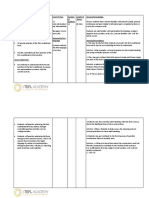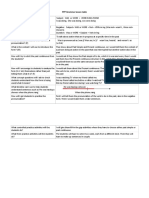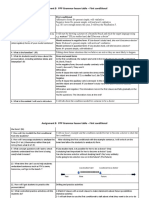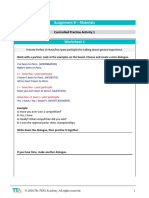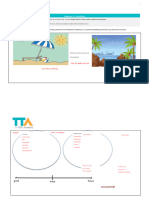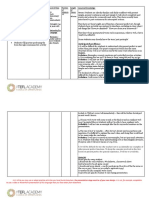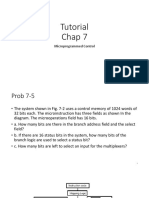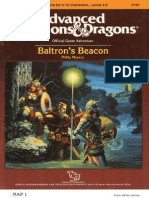AssignmentB Step1 Model4TeacherLanguage ModelAnswer
Uploaded by
Ockert DavisAssignmentB Step1 Model4TeacherLanguage ModelAnswer
Uploaded by
Ockert DavisAssignment B – Teacher Language
Instructions
This part of the assignment is set to enable us to assess your language grading, eliciting and
concept checking for grammar.
You must show:
A) some of the language you would use in the presentation.
B) the instructions you would give for one activity.
Use direct speech and present in a dialogue form showing predicted student contributions.
Example of Eliciting
T = Teacher S= Student
- T: So everyone, look at this picture, please. What can you see?
- S1: Man and woman
- T: A man and a woman, yes, can anyone say a bit more?
- S2: They're riding their bikes.
- T: Excellent. Good. What are their names do you think?
- S3: Donald and Melania.
- T:
Great idea! – So I'm putting that on the board (Teacher writes on the board 'Donald and
Melania are riding their bikes.')
Check the examples in Unit 7 to make sure you understand what is required.
N.B. If you do not use direct speech, you will be required to resubmit the whole assignment.
© 2020 The TEFL Academy. All rights reserved. 1
Assignment B – Teacher Language
This document should not be more than 3 pages long, including this page; approximately 700-1000
words in total.
a) Presentation
You do not need to show the entire presentation, but show us some of the language you would use to
elicit the target language from the context you have chosen, elicit the form, and concept check.
Show the Actual Words you would use for:
i) Eliciting the Target Language from the Context
T: (Referring to examples from warmer)What tense are all these examples on the board?
S: Past simple.
T: Good. Past simple. Do we know when these things happened?
S: Yes – we have times.
T: That's right. So let's look at one example. Idrissi, which do you think is the most interesting experience?'
Idrissi: 'Last summer I went to Paris.'
T: Good, yes I agree. I love Paris. Who wrote this? Who went to Paris last summer?
Rafat: Me
T: Lucky you, Rafat! Did you like it?
S: Yes, it very good. I love.
T: Now, I want to know if Rafat is the only person with this experience. How can we ask someone about this –
about going to Paris? Anyone?
S: Did you go to Paris?
T: Now that's good - a good past simple question, but when we are asking about general experience – we don't
know exactly when, we use a different tense. Does anyone know it?
Students look blank T: It begins with have. 'Have you...' Anyone?* (Wait for response if none, prompt them.)
'Have you ever mmm to Paris?' (Writes Have you ever ______ to Paris? On board.) Does anyone know what
goes in this space?
S: been?*
T: That's it! Have you ever been to Paris? (fills in gap on board). Everyone repeat: Have you ever been to Paris?
Ss: Have you ever been to Paris? Have you ever been to Paris?
T: Does anyone know the name of this tense?
S: Present perfect*
T: Well done! (Writes the name of tense at the top of the board).
* If I cannot elicit these answers from the students, I will tell them.
© 2020 The TEFL Academy. All rights reserved. 2
ii) Eliciting the Form
T: Let's look at the form then. (Points at I and Rafat in the affirmative examples.) These are the subject (Writes
'subject' in another colour). What comes after the subject?
S: have
T: Yes, have - or for he and she? (Points at Rafat example.)
S: has
T: Good (writes have/has on the board). That's the auxiliary verb. Have. And what comes after that? Does
anyone know what this is (points at been).
You remember when we first learned about past simple we looked at irregular verbs? Can you look at the
irregular verbs chart in your books? Page one hundred and nineteen -1-1-9.
Students open books.
T: Look for been – where is that? Can you find it? What's the name of the words in that category?
S: Past participle.
T: Excellent – well done. See everyone it's here in the third column (holds up book at points). This is called the
past participle or the third form. (Writes + past participle on board so it now says S+have/has + past participle)
T: I'm going to clean the board now, but don't worry I will give you a copy of this soon.
iii) Concept Checking
T: OK now, what's the name of this tense again?
S: Present perfect.
T: That's right and today we are looking at how to use the present perfect to talk about general experience.
(Writes Present perfect for talking about general experience on the board (Board plan 2).
Draws timeline showing now and illustration of e.g., Eiffel tower. )
T: Now we know I've been to Paris, and Rafat's been to Paris. We've been to Paris. Who else has been Paris?
Some students raise hands.
OK let's take Selma.
(Writes Selma's been to Paris under the timeline).
What are we talking about? Past, present or future?
S: Past.
T: Yes. It happened in the past. (Writes some question marks on timeline.) Do we know exactly when in the past?
S: Did it happen before Selma was born?
Ss: No!
T: So we know it happened before now, but after Selma was born. It happened some time in her life. (writes and
marks 'born' on timeline and draws arc to encase the question marks).
(Writes: Past/It happened some time in Selma's life before now/We don't know exactly when on board under
timeline.)
© 2020 The TEFL Academy. All rights reserved. 3
B) Instructions to ONE of the Activities in your Lesson
Freer Practice Activity
Project a copy of the worksheet on to whiteboard.
Teacher: OK everyone, I'm going to give you a copy of this in a minute, but let's make sure you all understand
what to do. Can you read the instructions on the screen, please?
Give students a minute to read
So Saffiya, what will you write in the boxes? (pointing at boxes in table)
Saffiya: Answers to questions
Teacher: That's right – the answers to these sentences (pointing). Selma, how many words should you write in
each box?
Selma: Only one
Teacher: Good. Just one word in each box. And change the order. So, for example, you might put the answer for
this one (pointing to sentences and boxes in the table) in this box. And the answer for this one could go here.
OK (writes in one of the boxes on the whiteboard). Look, I've written cat in this box. Why do you think I've
written cat? Which sentence is it for?
Student: Very expensive?
Teacher: (Laughing) No. Good idea, but she wasn't a very expensive cat. Any other ideas?
Student: Have you lost it?
Teacher: Yes, well done! That cat is something I've lost. She lived with us for 10 years, but now she has
disappeared.
OK so now I'll give you all a worksheet (hand them out). You have two minutes to think about the experiences
and write your answers in the boxes.
899 words (excluding headings)
© 2020 The TEFL Academy. All rights reserved. 4
You might also like
- Assignment B PPP Grammar Lesson Table - First Conditional: Main Clause If Clause100% (16)Assignment B PPP Grammar Lesson Table - First Conditional: Main Clause If Clause2 pages
- Assignment B - Teacher Language: Instructions85% (20)Assignment B - Teacher Language: Instructions4 pages
- An Evaluation of Cutting Edge Advanced: Assignment C - Part 196% (23)An Evaluation of Cutting Edge Advanced: Assignment C - Part 12 pages
- AssignmentA - Step1 - LessonPlanTemplate (1) (Repaired)100% (3)AssignmentA - Step1 - LessonPlanTemplate (1) (Repaired)7 pages
- Assignment B - Board Plan(s) : Form and Function91% (11)Assignment B - Board Plan(s) : Form and Function4 pages
- AssignmentA Step1 Text1-LowerIntermediate Template100% (3)AssignmentA Step1 Text1-LowerIntermediate Template14 pages
- TEFL LVL 5 Assignment A Text 3 (Passed Assignment)100% (1)TEFL LVL 5 Assignment A Text 3 (Passed Assignment)5 pages
- TEFL ACADEMY TASK 3 Evaluation Submission1100% (11)TEFL ACADEMY TASK 3 Evaluation Submission12 pages
- Assignment B PPP Grammar Lesson Table - First Conditional100% (3)Assignment B PPP Grammar Lesson Table - First Conditional2 pages
- TEFL ACADEMY TASK 3 Bibliography Submission1100% (2)TEFL ACADEMY TASK 3 Bibliography Submission11 page
- TEFL ACADEMY TASK 1 Bibliography Submission1100% (1)TEFL ACADEMY TASK 1 Bibliography Submission11 page
- TEFL ACADEMY TASK 3 Activities Submission1 PDF100% (3)TEFL ACADEMY TASK 3 Activities Submission1 PDF7 pages
- AssignmentB Step1 Model3aMaterialsContPractice ModelAnswer100% (1)AssignmentB Step1 Model3aMaterialsContPractice ModelAnswer2 pages
- AssignmentB Step1 Model2LessonPlanFormatandParagraph ModelAnswer100% (6)AssignmentB Step1 Model2LessonPlanFormatandParagraph ModelAnswer9 pages
- AssignmentA - Step2 - OnlineLessonPlanTemplate ALandri MinnieNo ratings yetAssignmentA - Step2 - OnlineLessonPlanTemplate ALandri Minnie6 pages
- Assignment A - Bibliography: Text 1 - Elementary100% (2)Assignment A - Bibliography: Text 1 - Elementary1 page
- Assignment B - Materials: Controlled Practice Activity 1100% (10)Assignment B - Materials: Controlled Practice Activity 12 pages
- AssignmentB Step1 Model1PPPGrammarLessonTable ModelAnswerNo ratings yetAssignmentB Step1 Model1PPPGrammarLessonTable ModelAnswer6 pages
- TEFL ACADEMY TASK 3 AuthenticTexts Submission1 PDF100% (2)TEFL ACADEMY TASK 3 AuthenticTexts Submission1 PDF2 pages
- Assignment A - Lesson Plan Template: 1.practicing Skimming and Scanning Skills in Reading0% (1)Assignment A - Lesson Plan Template: 1.practicing Skimming and Scanning Skills in Reading3 pages
- TEFL ACADEMY TASK 2 Bibliography Submission1No ratings yetTEFL ACADEMY TASK 2 Bibliography Submission11 page
- Assignment B - Bibliography: My Timeline Was Adapted From Timelines I Found OnNo ratings yetAssignment B - Bibliography: My Timeline Was Adapted From Timelines I Found On1 page
- TEFL ACADEMY TASK 2 TeacherLanguage Submission150% (2)TEFL ACADEMY TASK 2 TeacherLanguage Submission15 pages
- AssignmentB Step2 PPPGrammarLessonTable Template0% (1)AssignmentB Step2 PPPGrammarLessonTable Template2 pages
- AssignmentB Step2 Materials Template PDFNo ratings yetAssignmentB Step2 Materials Template PDF7 pages
- AssignmentB Step2 Bibliography Template PDFNo ratings yetAssignmentB Step2 Bibliography Template PDF3 pages
- AssignmentA Step3 PersonalReflectionGibbs Template100% (2)AssignmentA Step3 PersonalReflectionGibbs Template2 pages
- AssignmentB Step2 TeacherLanguage TemplateNo ratings yetAssignmentB Step2 TeacherLanguage Template3 pages
- AssignmentB Step1 Model5BoardPlan ModelAnswerNo ratings yetAssignmentB Step1 Model5BoardPlan ModelAnswer2 pages
- Davis Ockert AA Bibliography Submission1No ratings yetDavis Ockert AA Bibliography Submission11 page
- 21.8.21 Selected Solutions To Rudin's "Principles of Mathematical ...No ratings yet21.8.21 Selected Solutions To Rudin's "Principles of Mathematical ...172 pages
- A Study On Customer Relationship Management (CRM) of Honda Two Wheeler in Erode DistrictNo ratings yetA Study On Customer Relationship Management (CRM) of Honda Two Wheeler in Erode District14 pages
- Computer System Architecture Third Edition Tutorial - Chap - 07No ratings yetComputer System Architecture Third Edition Tutorial - Chap - 0725 pages
- Taxation: RC NRC RA Nraeb Nraneb SA On Taxable Income On Passive IncomeNo ratings yetTaxation: RC NRC RA Nraeb Nraneb SA On Taxable Income On Passive Income1 page
- Exercise 8 Polymerase Chain Reaction: Cell and Molecular Biology LaboratoryNo ratings yetExercise 8 Polymerase Chain Reaction: Cell and Molecular Biology Laboratory7 pages
- Assessing and Testing Hydrokinetic Turbine Performance and Effects On Open Channel Hydrodynamics - An Irrigation Canal Case StudyNo ratings yetAssessing and Testing Hydrokinetic Turbine Performance and Effects On Open Channel Hydrodynamics - An Irrigation Canal Case Study40 pages
- Final Module 02 - Characteristics of An EntrepreneurNo ratings yetFinal Module 02 - Characteristics of An Entrepreneur8 pages
- Sexual Sin and Sanctification Nov 29 2023No ratings yetSexual Sin and Sanctification Nov 29 20235 pages
- Kakegurui The Personality Database [PDB] AnimeNo ratings yetKakegurui The Personality Database [PDB] Anime1 page
- All Chapter Download Test Bank For Global Business Today, 6th Edition, Charles W. L. Hill, G. Tomas M. Hult, Thomas McKaig Frank Cotae100% (5)All Chapter Download Test Bank For Global Business Today, 6th Edition, Charles W. L. Hill, G. Tomas M. Hult, Thomas McKaig Frank Cotae54 pages
- Sea Marshall AU9 Operator Guide Rev 011 Low ResNo ratings yetSea Marshall AU9 Operator Guide Rev 011 Low Res56 pages
- Pornography and Addiction: Brain Chemistry Research and Porn (By Marnia Robinson)56% (9)Pornography and Addiction: Brain Chemistry Research and Porn (By Marnia Robinson)11 pages
- Assignment B PPP Grammar Lesson Table - First Conditional: Main Clause If ClauseAssignment B PPP Grammar Lesson Table - First Conditional: Main Clause If Clause
- An Evaluation of Cutting Edge Advanced: Assignment C - Part 1An Evaluation of Cutting Edge Advanced: Assignment C - Part 1
- AssignmentA - Step1 - LessonPlanTemplate (1) (Repaired)AssignmentA - Step1 - LessonPlanTemplate (1) (Repaired)
- AssignmentA Step1 Text1-LowerIntermediate TemplateAssignmentA Step1 Text1-LowerIntermediate Template
- TEFL LVL 5 Assignment A Text 3 (Passed Assignment)TEFL LVL 5 Assignment A Text 3 (Passed Assignment)
- Assignment B PPP Grammar Lesson Table - First ConditionalAssignment B PPP Grammar Lesson Table - First Conditional
- AssignmentB Step1 Model3aMaterialsContPractice ModelAnswerAssignmentB Step1 Model3aMaterialsContPractice ModelAnswer
- AssignmentB Step1 Model2LessonPlanFormatandParagraph ModelAnswerAssignmentB Step1 Model2LessonPlanFormatandParagraph ModelAnswer
- AssignmentA - Step2 - OnlineLessonPlanTemplate ALandri MinnieAssignmentA - Step2 - OnlineLessonPlanTemplate ALandri Minnie
- Assignment B - Materials: Controlled Practice Activity 1Assignment B - Materials: Controlled Practice Activity 1
- AssignmentB Step1 Model1PPPGrammarLessonTable ModelAnswerAssignmentB Step1 Model1PPPGrammarLessonTable ModelAnswer
- TEFL ACADEMY TASK 3 AuthenticTexts Submission1 PDFTEFL ACADEMY TASK 3 AuthenticTexts Submission1 PDF
- Assignment A - Lesson Plan Template: 1.practicing Skimming and Scanning Skills in ReadingAssignment A - Lesson Plan Template: 1.practicing Skimming and Scanning Skills in Reading
- Assignment B - Bibliography: My Timeline Was Adapted From Timelines I Found OnAssignment B - Bibliography: My Timeline Was Adapted From Timelines I Found On
- AssignmentA Step3 PersonalReflectionGibbs TemplateAssignmentA Step3 PersonalReflectionGibbs Template
- 21.8.21 Selected Solutions To Rudin's "Principles of Mathematical ...21.8.21 Selected Solutions To Rudin's "Principles of Mathematical ...
- A Study On Customer Relationship Management (CRM) of Honda Two Wheeler in Erode DistrictA Study On Customer Relationship Management (CRM) of Honda Two Wheeler in Erode District
- Computer System Architecture Third Edition Tutorial - Chap - 07Computer System Architecture Third Edition Tutorial - Chap - 07
- Taxation: RC NRC RA Nraeb Nraneb SA On Taxable Income On Passive IncomeTaxation: RC NRC RA Nraeb Nraneb SA On Taxable Income On Passive Income
- Exercise 8 Polymerase Chain Reaction: Cell and Molecular Biology LaboratoryExercise 8 Polymerase Chain Reaction: Cell and Molecular Biology Laboratory
- Assessing and Testing Hydrokinetic Turbine Performance and Effects On Open Channel Hydrodynamics - An Irrigation Canal Case StudyAssessing and Testing Hydrokinetic Turbine Performance and Effects On Open Channel Hydrodynamics - An Irrigation Canal Case Study
- Final Module 02 - Characteristics of An EntrepreneurFinal Module 02 - Characteristics of An Entrepreneur
- All Chapter Download Test Bank For Global Business Today, 6th Edition, Charles W. L. Hill, G. Tomas M. Hult, Thomas McKaig Frank CotaeAll Chapter Download Test Bank For Global Business Today, 6th Edition, Charles W. L. Hill, G. Tomas M. Hult, Thomas McKaig Frank Cotae
- Pornography and Addiction: Brain Chemistry Research and Porn (By Marnia Robinson)Pornography and Addiction: Brain Chemistry Research and Porn (By Marnia Robinson)
